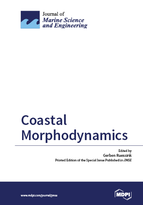Coastal Morphodynamics
A special issue of Journal of Marine Science and Engineering (ISSN 2077-1312).
Deadline for manuscript submissions: closed (29 February 2016) | Viewed by 61517
Special Issue Editor
Interests: nearshore waves; currents; coastal geomorphology; nourishments; aeolian processes; remote sensing; climate-change impacts
Special Issues, Collections and Topics in MDPI journals
Special Issue Information
Dear colleagues,
Coasts are often beautiful landscapes with high biodiversity and provide a large and rapidly growing proportion of the world’s population with living and working environments, recreation, food, and drinking water. Coasts are also one of the most dynamic natural features on Earth and are also under increasing pressure by human activities and climate change. This Special Issue has been launched to compile the current state-of-the-art and future perspectives in the understanding of coastal morphodynamics, the complex and perpetual interaction between waves, tides, currents, sediment, biota, morphology, and humans. A solid understanding of, and skills in, predicting coastal morphodynamics is critical if we wish to manage our coasts in a sustainable manner.
Contributions are invited that deal with the natural or human-induced dynamics of:
1. Sandy beaches/nearshore and coastal dunes
2. Barrier island systems, including tidal inlets/deltas, and wash-over systems
3. Tidal flats and salt marshes
4. Mangrove shorelines
5. Rock coasts
6. High-latitude coasts
Contributions can be based on field observations, including novel remote-sensing techniques, laboratory experiments, and/or morphodynamic modeling. The focus will be on coastal morphodynamics acting on time scales between days (e.g., a storm) and a century (e.g., human activities and climate-change effects).
Prof. Dr. Gerben Ruessink
Guest Editor
Manuscript Submission Information
Manuscripts should be submitted online at www.mdpi.com by registering and logging in to this website. Once you are registered, click here to go to the submission form. Manuscripts can be submitted until the deadline. All submissions that pass pre-check are peer-reviewed. Accepted papers will be published continuously in the journal (as soon as accepted) and will be listed together on the special issue website. Research articles, review articles as well as short communications are invited. For planned papers, a title and short abstract (about 100 words) can be sent to the Editorial Office for announcement on this website.
Submitted manuscripts should not have been published previously, nor be under consideration for publication elsewhere (except conference proceedings papers). All manuscripts are thoroughly refereed through a single-blind peer-review process. A guide for authors and other relevant information for submission of manuscripts is available on the Instructions for Authors page. Journal of Marine Science and Engineering is an international peer-reviewed open access monthly journal published by MDPI.
Please visit the Instructions for Authors page before submitting a manuscript. The Article Processing Charge (APC) for publication in this open access journal is 2600 CHF (Swiss Francs). Submitted papers should be well formatted and use good English. Authors may use MDPI's English editing service prior to publication or during author revisions.






